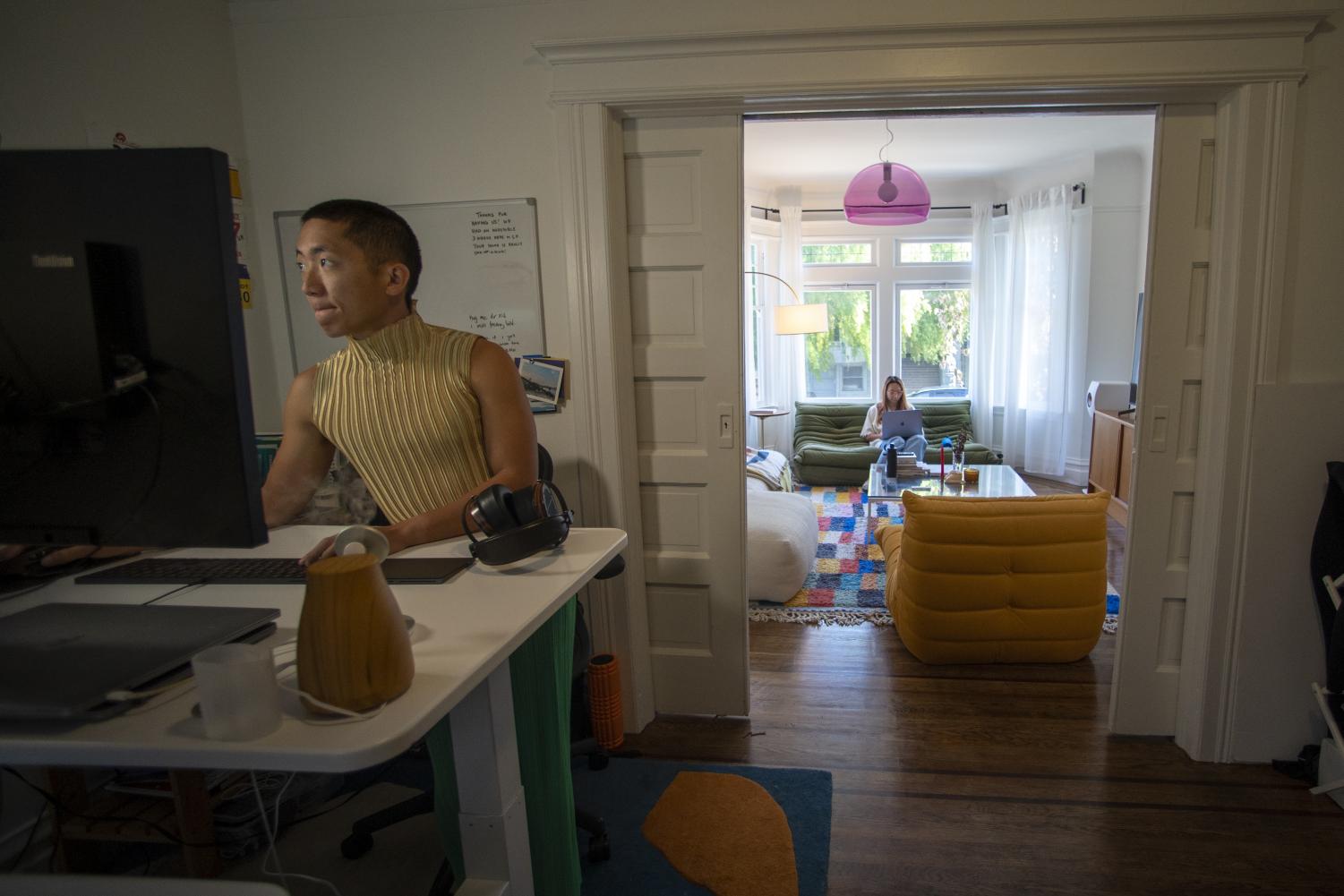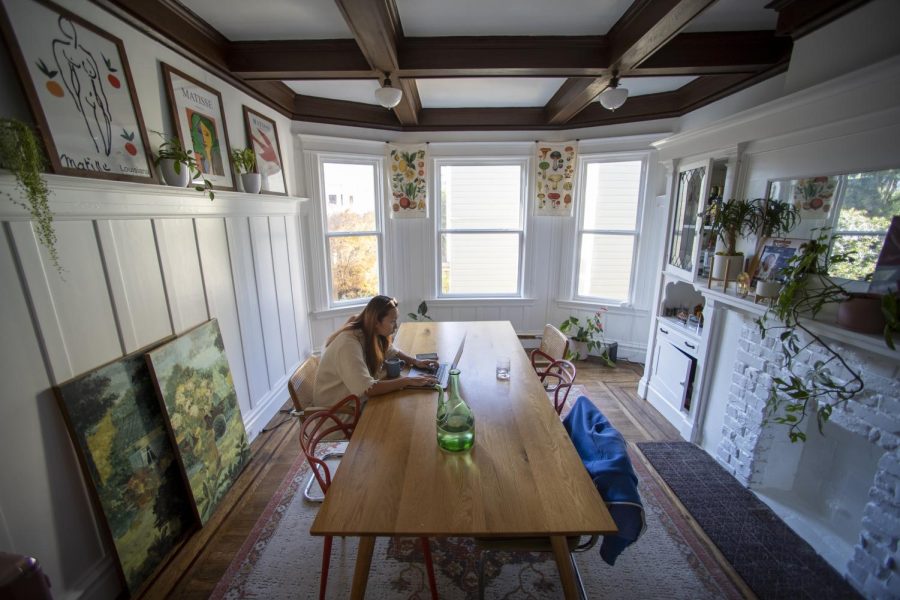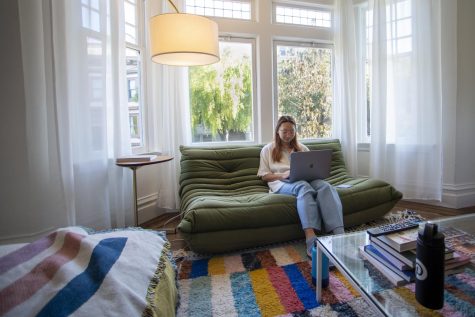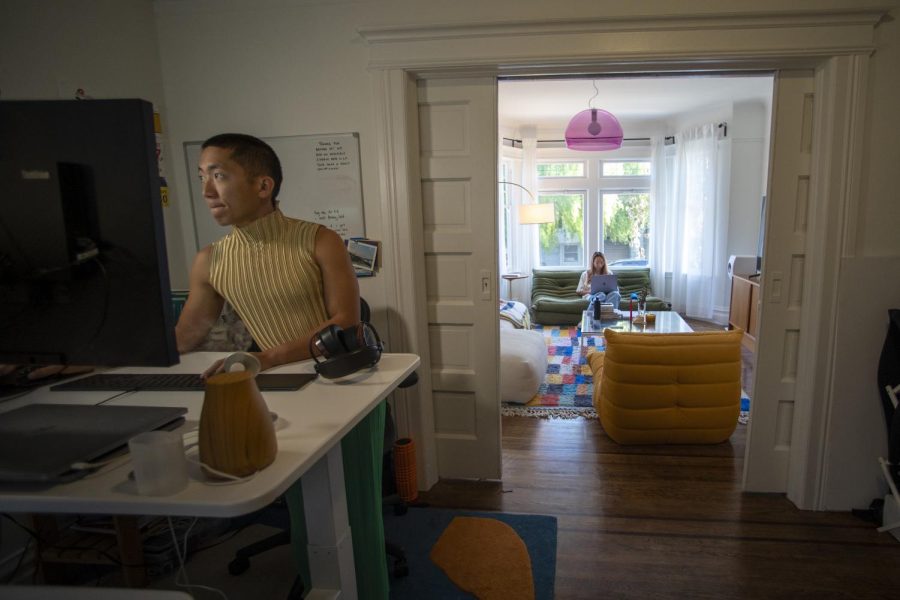
KK Interchuck (she/they) is an amateur guitarist, cat mom, and journalism and women and gender studies double major in her last semester at SF State. A...


How people’s relationships with their homes have changed during the work-from-home era
December 15, 2021
After a long day or even longer night, home is the place to return to where one can relax and unwind. Alas, the era of working from home is among us, which means those who work remotely can no longer leave work at the door.
What once was a haven has now been infiltrated. But is it all bad?
According to a survey conducted by the Pew Research Center in 2020, 54% of remote workers said they would want to work from home “all or most of the time,” even after the pandemic. A third of participants said they would prefer a hybrid schedule with some days in-office and others at home, while just 11% said they would rarely or never want to work from home.
Hiba Khalid, the operations and marketing manager for a Japanese restaurant in San Diego, California, began working from home in April 2020. For Khalid, 26, working from home is ideal. She creates her own schedule, has time to run errands or complete chores and can wake up just minutes before the actual workday commences.

Her mental health began to suffer when she realized how difficult it was for her to separate work from home.
Khalid lives with her family where she spends most of her time working out of her bedroom without a proper desk or chair. She fashioned an old vanity into a makeshift desk by removing the mirror, which still sits against the wall beside the desk. While she works, she perches on a faux fur cushion atop a backless stool.
“My room is my office,” she says. It can be mentally taxing being unable to return home and essentially “forget” about work. “It’s still going to kind of be a presence in my space,” she says.
Because she lives and primarily works out of the same bedroom, Khalid began finding it increasingly difficult to refrain from thinking about work as she would wind down at night.
Twenty-three-year-old software developer Sophia Hu runs into a similar issue. She primarily works from her San Francisco home, visiting the office about twice per week on average.
Although Hu appreciates having more time in her day without having to commute, the lack of separation between work and home also takes a toll on her.
“There’s very little separation between your time and company time,” she says.
It used to be rare for Hu to think about work once returning home. “But now when I’m at home,” she says, “if someone Slacks me, I have to look at it.”

She describes the days she does go into the office as “a breath of fresh air.” The separation is much more distinct for her.
“When I get home, I feel like I don’t have to work anymore, finally,” she says.
Another disadvantage of working from home is that the number of possible distractions increases dramatically. For Hu, this regularly manifests in low-productivity days.
After an early morning bike ride, Hu might return home and shower before 9 a.m., head to her bedroom and turn the space heater on, only to realize hours later that she had accidentally drifted off to sleep. By the time she wakes it’s lunchtime, and she is greeted by a looming list of errands she told herself she’d get done that day. Eventually, workday hours conclude and she hasn’t gotten much done for actual work.
A low-productivity day isn’t so bad or uncalled for from time to time. What really bothers Hu is how these days make her feel.
“It makes me view myself as a lazy person,” she says. “It makes me think of myself as unproductive and I think, ‘What’s wrong with me?’”
Hu says that going to the office results in such higher productivity than at home that it makes the trek across town worth it.

“One day in the office I’ll get as much work done as two days at home,” she says. “There’s nothing to do (in the office) except work. So I just work.”
In Hu’s case, her office also happens to be a spacious and quiet space with complimentary snacks, coffee, tea and lunch. So not only are there little to no distractions but there are also built-in perks.
However, working from home still has its advantages. Khalid appreciates that she is in complete control of her workflow, taking breaks as necessary, grabbing a snack or running a load of laundry before getting right back to it.
“There’s no boss watching over me, so I can comfortably work at a pace that suits my energy and my own mindset versus just going really hard and trying to get everything done,” she says.
Humans are dynamic beings whose moods and energy levels differ day to day. Because of this, Khalid appreciates the freedom and flexibility that telework provides. She can be completely relaxed in her own space with no pressure to look or act a certain way 100% of the time.
Although Khalid wishes she had a clearer distinction between work and home, she still manages to appreciate that whenever she needs a break from work, she can focus on her home and environment and then revert to work mode.
“I can go vacuum or wash dishes if I want to,” she says. “It does help me destress because then my home environment is tidy. And then I can put that aside and be like, ‘Okay, I’m going back to work now.’”
This distinction isn’t impossible to achieve. Bay Area interior and furniture designer Sara Jaffe says that those struggling with separating work and home can make small changes to their routines and spaces to make the boundary clearer.
If you have the luxury of space, Jaffe suggests working from different areas of your home to switch up the monotony of working from a single room. Khalid does this by working from her family dining table one day and then back to her bedroom the next.

“You need to enrich your environment in a way,” Khalid says. “I’ve even started going to cafes sometimes and working there for a day.”
Jaffe says those with more limited room have other options as well. There are rituals you can create to mentally and physically separate your working space from your living space. When Jaffe finishes working at home, she goes through the ritual of putting all of her work completely away instead of leaving it on her desk.
“When things are put away, you can clear your head,” she says.
A more visual separation can be made in smaller spaces with something as simple as a curtain or room divider. Additionally, if something like your kitchen table doubles as your desk, you must make the conscious decision of when you will use that space for work, and when you will use it to eat, Jaffe explains.
“There’s a psychological way to adapt, and there’s a physical way,” she says.
Lastly, Jaffe stresses the importance of curating your space to “soothe your spirit,” which can be done with simple things like art, plants, pieces of furniture, or even colors. When you make these decisions, you are crafting your own space.
“I think that that’s what creates sanctuary,” she says. “It’s saying, ‘When I come home, I feel glad to be here.’”

KK Interchuck (she/they) is an amateur guitarist, cat mom, and journalism and women and gender studies double major in her last semester at SF State. A...